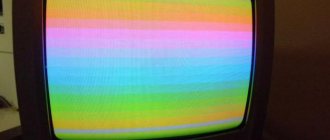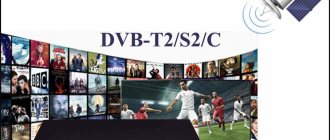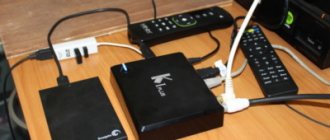Surely many Russian users interested in terrestrial television have already heard about the gradual transition to digital broadcasting throughout the country. Many TV viewers have no idea what needs to be done to switch to digital TV, whether they need to purchase additional equipment or not. In this material, I will try to answer all the questions of users planning to use digital TV on their TVs, because the digital television standard, thanks to information technology, is being transformed into a new service for the viewer.
Advantages of digital TV and disadvantages of analogue
The main disadvantage of the analog signal is poor protection against interference, as well as a fairly wide band of the radio frequency spectrum required for broadcasting one channel. Therefore, on the air we were limited to a maximum of two dozen color channels, and on cable networks an average of 70. With an analog signal, it is quite difficult to create a service convenient for the user and operator (for example, to implement the ability to quickly connect and disconnect channel packages). In addition, analog TV requires high power transmitters with a large coverage area.
A digital signal does not have these disadvantages. The main advantage of digital TV is that the signal can be compressed using modern algorithms (for example, MPEG). By compressing the signal in the frequency range of one analogue television channel, you can fit up to 10 digital channels with approximately the same picture quality. Exactly how to encode and compress a signal is determined by a single standard. Today in Europe and Russia the main family of standards is DVB - a product of the international consortium DVB Project. The family includes standards for satellite, terrestrial, cable and mobile television, differing in the degree of compression, noise immunity and other parameters (depending on the transmission medium used).
Preparations for the transition to digital TV lasted many months: people were explained how to set up their TVs for digital reception, how to connect special set-top boxes, and how not to fall for scammers. And now we can say with confidence that the transition to digital has been successfully completed.
Berezkin Evgeniy Nikolaevich expert of the LAN-ART company on television equipment"
World digital TV standards
In America, the ATSC standard, developed by the Advanced Television Systems Committee group, is widespread, in Japan ISDB (Integrated Services Digital Broadcasting) is rapidly developing, Russia has followed the European path, adopting the DVB (Digital Video Broadcasting) standard as a basis.
Let's go digital
A massive transition to digital television broadcasting standards in the world took place in the early 2000s. In our country, state broadcast channels began the transition to digital in 2009 as part of the federal program “Development of television and radio broadcasting in the Russian Federation for 2009-2015.” DVB-T2 was chosen as a unified digital broadcasting standard, which allows more digital channels to be placed on the frequency band than its predecessor DVB-T, but this does not mean an increase in the resolution of the broadcast picture. We should expect HD quality on air only in the distant future. Today, DVB-T2 transmitters operate almost throughout the country. In some places, only the first multiplex (package of 10 digital channels) is currently on; in other areas, the second is already available. This means that if you have an appropriate TV or an additional set-top box, you can receive and watch 20 channels for free in decent quality and almost without interference. The program for the development of digital television in Russia involves updating only distribution and transmission equipment. Viewers have to think about replacing receivers on their own, because to receive a digital terrestrial television signal, you need a DVB-T2 TV tuner , and this is only available in new TV models.
To receive a signal with older devices, TV viewers will have to purchase and install a set-top box at home.
Basic moments
- The color rendering system is the output of a color image using the interlaced method. Several standards for such systems are used in the world - NTSC, PAL and SECAM. Each standard operates on a single technology, provides the overlay of 3 primary colors (red, green, blue) and transmits them using cathode ray tubes.
- The color rendering standard is a technology implemented for image output, and not for broadcasting. It is used for analogue television broadcasting and color film editing.
- The NTSC standard was first adopted in the USA. Then it spread to Japan. 14 years later, France introduced its SECAM system, which was adopted by the Soviet Union. And Europe in the same year standardized PAL, which was introduced by Germany.
- In the 1990s, the Russian Federation and the CIS countries, together with SECAM, implemented PAL, which resulted in problems for some owners of old TVs. To solve the problem, a soldered SECAM/PAL decoder was needed. To Pal Sekam's question, it can be answered this way - it is a decoder for implementing compatibility between two technologies, which smoothly migrated into a single PAL standard.
Video compression formats in the DVB standard
The DVB standard is not a complete description of the digital television format, but a method for a specific broadcast implementation. Various video encoding systems can be used within this standard (MPEG-1, MPEG-2, MPEG-4, etc.), but not all of them are backward compatible. The most common compression formats are MPEG-2 (the best picture quality) and MPEG-4 (which has the best compression). Russian digital TV will use MPEG-4 compression. TVs that support the MPEG-4 standard can also work with MPEG-2, but not vice versa, since MPEG-2, in turn, is used by cable operators who are not limited in frequency band and the picture compressed with this codec is much higher quality.
What is DVB-C?
The method of transmitting digital streams from DVB-C requires the presence of a cable. This is a wired TV that is supplied by the provider. Almost all new devices are capable of working with this technology. If yours is not marked DVB-C, you can purchase the appropriate tuner and order the connection of certain software packages from your provider. Such services are the most common and, as a rule, are not expensive compared to other types of connection.
This system uses MPEG-2 codecs when transmitting video and audio. DVB-C can also often be found in large television network organizations. They are also used in conjunction with satellite antennas. You can also watch broadcasts with DVB-C technology via a PC or laptop. But for this you need separate equipment - a TV tuner. It connects to the motherboard in the system unit.
A device that can decode the signal from DVB-C switching stations processes the data quite well. Usually the quality of the broadcast image does not cause any complaints. Often providers offer to buy receivers from them at a discount if your device cannot receive a signal in this format. The TV set-top box is connected to the TV with a cable of three connectors. After that, you can buy special cards to watch TV shows for the entire period (payment period).
DVB-C is in many ways different from DVB-T2, DVB-S2, DVB-T. First of all, the architecture of the signal receiving device. Such set-top boxes can show up to 150 programs. Setting up other channels that are not in the package yourself is not possible. The quality of the picture on the screen will not depend on the distance of your TV or set-top box from the source itself.
Analog antenna or satellite dish?
The principle of operation from a satellite dish . You need to buy and install a set of signal receiving equipment: a “dish”, an access card to satellite channels and a set-top box (satellite receiver), which ensures the transformation of the received digital signal into an analogue one that is understandable to the TV. A satellite receiver is a device that provides signal transformation from DVB (various decoding systems) into a format perceived by a household TV. You can connect a cable operator’s wire or a familiar terrestrial television antenna to such a set-top box. Intermediate equipment may not be needed, since many modern TVs support the DVB-T , which means compatible with MPEG-4 compression, and a special antenna is not required to receive a digital signal.
In order not to change the TV, there is an alternative - CAM module . It is a kind of expansion card that is inserted into the TV and gives it the functionality of a set-top box, but to use this component the TV must have a CAM interface. I will tell you more about the CAM module in the section on digital cable TV.
Satellite platforms officially operating in Russia use DVB-S and DVB-S2 standards. To receive satellite digital TV, you need a properly installed antenna (the diameter of which depends on the geographical location of the subscriber and the selected satellite), a receiver with a valid access card and a TV.
Difference of standards
PAL SECAM NTSC what is it? Each color rendering system offers a number of characteristics that affect compatibility and pairing:
- NTSC uses 525 lines of picture with a storyboard of 30 FPS. This need is due to the parameters of the US power grid - 230V and 60 Hz. The predominant colors are red and blue.
- PAL and SECAM work on the ATB color standard, which has 625 lines per frame. It is noteworthy that all of Europe uses 25 FPS, which are tied to the properties of the electrical network - 220V and 50 Hz. The main colors are red, green, blue.
The two video standards PAL and SECAM are compatible, but the standard differs significantly from NTSC, since the latter technically involves fewer cathode ray tubes transmitting primary color signals.
There were cases in the early 90s when color TVs displayed a black and white picture, due to:
- By watching analog TV on a recently purchased Japanese-made TV that only works with NTSC, which does not work in Europe and the post-Soviet countries.
- Watching video from cassettes on which the video track was recorded using the NTSC standard. As a result, this color rendition was not recognized by videocassette players in the USSR and Europe.
To eliminate this problem, it was necessary to additionally purchase a decoder and integrate it into the board of the picture playback device.
If you have a choice of PAL or NTSC, then definitely choose PAL to watch the remaining ATV in Russia.
DVB-T2 - a new standard for digital television
The DVB-T2 standard is the second generation of the European digital terrestrial broadcasting standard DVB-T. It is designed to improve the capacity of television networks by at least 30% compared to DVB-T with the same network infrastructure and frequency resources.
Advantages of the DVB-T2 standard:
- increasing the number of channels in the broadcast package;
- the possibility of organizing “local” broadcasting;
- the possibility of developing high-definition television;
- release of ethereal frequencies.
The use of the DVB-T2 standard in subscriber devices creates a technological basis for the provision of additional services and HDTV through digital terrestrial television networks. In the future, it is possible to introduce a new interactive technology, HbbTV, thanks to which the capabilities of a familiar TV will become an analogue of Smart TV. So when buying a TV, pay attention to support for the DVB-T2 standard.
What are the little-known letters DVB?
“DVB” is the first letter of a consortium of European countries that have invented digital TV standards in a row. In English, these three letters have the following meaning: project: digital video broadcasting. The main difference between regular TV and digital TV is the clarity and stable image picture. Older generations of TV viewers remember analog antennas and channels with ripples that were almost impossible to get rid of.
Everything changed with the advent of a new type of video delivery to TV screens. The DVB project is developing in all directions and types of image delivery: terrestrial, cable, airborne and others. Today, such data is transported using signal encoding. A newly designed type of data transmission allows us to encode not only the image signal to our televisions, but also additional data. Such as, for example, a TV program guide.
Due to the fact that there are essentially several different methods of transmitting information (via cable, satellite, etc.), additional technology abbreviations have appeared (DVB-T, DVB-C, etc.). Which will be discussed further. If your new TV supports one or more of these standards, this is definitely a plus for you. Since other TV viewers need to purchase a separate set-top box to connect the corresponding television. Therefore, the price of a TV if it has DVB abbreviations on its body will be higher than others.
Image resolution in digital television
A regular television signal has “standard definition” ( Standard Definition , SD ), and there is also an option for an improved quality signal ( “high definition” ) - 480p, 576p, 480i or 576i. The number indicates the number of pixels in height, and the letter indicates the scan type - interlaced (i) or progressive (p). The number of pixels in width depends on the aspect ratio of the picture, which leads to the existence of several more types of high-definition signal. There are at least four SD options in modern analog TV. If your TV supports DVB-T, there will be no compatibility problems. Cable and satellite operators typically offer some kind of “high definition” picture option. Currently, the DVB-T standard is considered obsolete and has been replaced by DVB-T2. In Russia, digital broadcasting is carried out in the DVB-T2 standard with support for the MPEG4 video compression standard and the Multiple PLP mode.
High Definition TV (HDTV) is the best quality at the moment. HDTV comes in two flavors - 1080i and 720p. The 720p format has a resolution of 1280x720 pixels and progressive scan, while the 1080i format has an image resolution of 1920x1080 pixels with interlaced scan. Formally, the number of pixels in a 720p image is two times less than in 1080i, but in 720p a whole frame is formed in one pass, and in 1080i half. 1080i is more suitable for video with a minimum of movement and maximum detail, and 720p is the opposite, for this reason there is no need to compare them.
Digital cable television
In parallel with the transformation of terrestrial television, cable operators are also thinking about optimizing the frequency spectrum and developing services. In the field of cable television, a typical development path is the launch of broadcasting in the DVB-C format (a version of the DVB standard for cable networks, characterized by a lower compression ratio and less noise immunity compared to the terrestrial standard, which is quite acceptable in cable). When switching to digital, operators have the opportunity to flexibly manage content, for example, allocating channel packages, opening and closing access to them for users, etc. To decrypt encrypted channels on the subscriber’s side, so-called access cards are used. Each encoding system has its own, but the standard provides a universal connector for connecting a CAM module to a TV or set-top box for a specific type of encoding, into which an access card is already installed.
Installing a CAM module into a TV
Like DVB-T2, the cable version of digital TV supports high-definition content (HD). But it is up to each operator to decide whether or not to include HD channels on their network. It should be noted that almost all cable networks in Russia, where digital television has been launched, offer HD channels. Some even experimented with 3D channels.
Equipment for receiving DVB-T2 and DVB-C
To view a digital signal from cable networks, you need equipment that accepts the appropriate standard. TVs and set-top boxes with DVB-C support went on sale back in 2007, so if you have changed your TV receiver in the last few years, then you most likely have support for the cable version of the DVB standard. Ideally, to connect to cable digital television, the owner of such a TV only needs to purchase a CAM module from the operator and install an access card there. But since each operator determines its own policy for the operation of the service, CAM modules are sometimes not offered, and then subscribers need to purchase an intermediary device - a set-top box with support for the conditional access system (CAS) used by the operator. Most often, such devices are “tailored” for only one VAT.
If a cable operator offers HD channels, then in order to watch them, the equipment must also accept HD resolution. In general, support for DVB-C (DVB-T/T2) does not at all mean support for Full HD (picture resolution 1920x1080 pixels for both TVs and set-top boxes). The situation is similar with 3D channels.
The fact that a TV supports the cable version of the DVB standard does not mean that it also decodes the over-the-air digital version. Deliveries of equipment with DVB-T2 support to our country began only in 2012. So we can say with confidence that if your TV was purchased earlier, then it will not “understand” the DVB-T2 standard. Cable set-top boxes also rarely accept DVB-T2. If your TV device does not allow you to receive terrestrial “digital” by default, you do not have to change it. You can limit yourself to purchasing a set-top box for DVB-T2. Digital TV tuners of this standard are available in various designs, including as compact accessories for tablets and computers with a USB connector.
Popular formats on TV. What can be used on local air
During #MediaCA, Arina Borodina, a television commentator and author of television reviews on “Echo of Moscow”, Russia, spoke about what Russian television viewers are watching now, about television viewing trends in general.
Author: Arina Borodina. Top 10 most popular formats on Russian airwaves:
1. Live broadcast of the Victory Parade on Channel One on May 9 (annually)
2. New Year's greetings from the President (annually)
3. Live broadcast of the Eurovision Song Contest (annually, except for the situation with Ukraine)
4. “The Voice” (sixth season) and “The Voice.” Children" (season five)
5. TV series are the main driving force of the broadcast
6. Qualifying rounds and games of the Russian national team for the World Cup and European Football Championship. Sometimes the World Hockey Championship final, if the Russian national team is playing
7. Direct Line of the President (annually, two state channels)
8. “News of the Week”, “Sunday Evening” with Vladimir Solovyov
9. Program “Time”, sometimes “News”
10. “The best of all”, “Amazing people”, “Let them talk” (previous years) - the most popular topics in previous years.
Main trends in popularity, “fathers and sons”. Family viewing. "Boys" on "Friday".
https://www.youtube.com/watch?v=TjYDviUVl9Y
2. TV formats that can be used on local broadcasts, based on the characteristics of the region, national traditions and social context
The main thing is to be able to find and develop personnel, your own presenters, who are known to your audience, city, district, region, region. They know and trust. The latter, of course, is ideally decisive. And so that they themselves understand and know the audience with whom they are speaking.
Journalistic projects that do not require a large budget and can always find their place on the grid both in the morning and afternoon broadcast and in the late broadcast, after the main news, series and shows:
— historical and local history essays. But not monotonous boring canvases, but finding interesting facts and details, perhaps in the form of a quest. And it’s better if this is done by young presenters talking on camera. https://www.youtube.com/watch?v=E5eF3-8UMGs (Tobolsk, Krasnoyarsk Territory, TV company Afontovo (Krasnoyarsk), short stories about city streets. TV company Efir, Kazan.
- films about national customs and traditions (but there are probably enough of them on your broadcasts, but you can also talk about the traditions of neighboring states, peoples of the world, neighboring states and look for new moves)
- films - portraits. There is nothing more interesting than the fate of a person. These can be thematic films - portraits. Cycles once a week. Cycles about professions of all kinds: doctors, teachers, shepherds, builders...
And you can make portraits - personal sketches. Parfenov in the old weekly “Namedni” had a weekly special project “Hero of Capitalist Labor”, where, together with the newspaper “Vedomosti” (again, you can involve journalistic resources of Internet media - electronic and print), where portraits of entrepreneurs, businessmen, owners of various businesses.
This section featured famous Russian entrepreneurs, a story about how they started their business, and what they encountered.
There were also portraits of less famous businessmen. The RBC channel, author and journalist Roman Super, launched an excellent series of stories “Heroes of RBC”, which also featured people who themselves had built their own business from scratch.
These are not so much economic portraits as human stories, about how a person builds his life and his business. Here is the story of Arkady Mayofis, the founder of the Tomsk television company TV-2, after the liquidation of which he left for and started a life and a new business there from scratch
https://www.youtube.com/watch?v=9Wrw5nVLDjgIsrael
- programs - interviews. Both relevant, based on the events of the day, and timeless, with a bright, thinking person who knows how to express his position. Of course, it’s good when there is an informational reason, but it is not always necessary. But in the absence of a reason, the role of the presenter always becomes more complicated; his class and professional skills are important. Interviews, depending on the channel format, can be broadcast both during the day and at night. With questions from the audience and questions from the presenter
- morning broadcast. Own production. These are small sections within the morning block - a win-win option for closing the morning lines on average until 9 am, but sometimes the morning channel and the thematic blocks adjacent to it can be extended until 10-11 am.
One of the best program blocks was on Channel Five, “Morning on 5”.
Most large regional television companies in Russia have their own morning broadcasts.
I really liked the Kazan TV column about forgotten things and advertisements, about lost people. It is clear that the morning and afternoon blocks can always be filled with sections about cooking, leisure, sports, posters, family problems, and a wide variety of formats.
— thematic programs about economics and money. The “Money” program on “Rain” talks quite cheerfully and clearly about complex issues.
— there are programs about emergency incidents that are traditionally in demand. But it is always possible to involve local residents in such programs. This is either interactive in the studio, or a people's correspondent, when residents themselves report to the studio - either by calls or messages on social networks about certain incidents or emergencies.
- daytime and evening shows with different principles, outside of politics and social context, women's programs. Or the events of the day, with current interviews - “A useful evening” (analogy - sewing, cooking, music..., Ekaterinburg channel 41).
Or it’s something Open Channel does - communicating with viewers, calling the studio, reading social networks. At the end of the day.
- game and entertainment programs that are made under license from Western companies do not always pay for themselves in terms of costs, but you can always make your own analogue on local air. The topic of relationships between fathers and children in any television format is now popular. Both song and dance competitions, if this is in demand among the audience, are possible. Children and adults. Or even in half - children and adults. There may be some here too.
- children's and youth programs. There are no special recipes here. But the most popular things now can always be taken from the networks, comments, YouTube channels, and all this can be “passed” through the air.
Separately, it is worth mentioning special projects and interprograms. Now there are a lot of opportunities to do this with the help of feedback from the viewer, to include social networks, websites, friendly media, and to join forces.
— reality Again, by the simplest means, when people film their day on their phone cameras, synchronizing the lives of several people who are simultaneously doing something on the same day. Especially with young heroes. Everyday life filmed step by step.
— promotions dedicated to national and memorable dates. Remember your families, departed and dead relatives, an analogue of the “Forgotten Regiment” or something similar, taking into account traditions and national context.
— charity events and telethons, when end-to-end broadcasting can raise money to help people, in particular children. Or for the elderly, or funds for animal shelters. Or to help those affected by natural disasters. For example, there is such a section on Channel Five: Day of Good Deeds. It is very popular and well made. Collects decent ratings.
Special project – “I am a reporter” (Surgutinform TV). Above I mentioned the information analogue of the “people's correspondent”.
A variety of videos, of various kinds. This is a very popular format on television now. What was filmed by the people living next to you. Even the “Let Them Talk” episodes, which included YouTube videos, always collected very good ratings.
Separately, I would like to recommend these videos, which were made by the famous journalist and linguist Ksenia Turkova. How to pronounce certain words correctly. The video lasts only 30-40 seconds.
It fits perfectly into the cross-program space of any channel, is very cheap to produce and is very precisely designed for any audience. Not to mention the benefits. Ksenia made these videos in Ukraine, as well as for an Estonian TV channel. Recorded and broadcast. Something similar can be done in national languages.
In addition to broadcasting, it can be used on radio and Internet platforms.
3. The overall result is about the connection between national television projects and local broadcasting.
Television over the Internet
An Internet channel is also used to transmit a digital television signal between the telecom operator and the viewer’s TV. Globally, network television projects can be divided into IPTV and OTT. Although OTT is a type of IPTV, they are usually considered as different services. It is generally accepted that IPTV is a service within the operator’s network that provides broadcast of channels in real time, and OTT (Over The Top) is any video service (not only broadcast of channels, but also cinema, that is, video on demand) provided via the Internet . Many common operator platforms support both options within the same service, so it makes no sense to talk about a strict separation of IPTV and OTT.
Equipment for IPTV or OTT
At the moment, TV manufacturers have not yet agreed on a single standard for IPTV (OTT) services. Therefore, for now, viewers are forced to choose between several available options for watching TV over the Internet:
- Smart TV – operators provide applications for the operating systems of smart TVs to connect to the service. It is important that you cannot use a third-party solution here: the only one who can release such a program for this particular network is the operator providing the service.
- IPTV set-top boxes - the ability to connect IPTV to a TV is determined by the presence of connectors for connecting a set-top box. The cost of such devices, however, is somewhat higher than that of broadcast consoles. There are even universal devices that work in the networks of different operators (reconnection may require changing the gadget’s firmware, but at least not purchasing new equipment), and also serving as a home media center (for example, Dune HD).
- watching channels on a computer - often the “computer” package is smaller and you can rarely find HD channels there.
- television on mobile devices.
Note that IPTV can broadcast HD, 3D and even channels. But to view them you need a set-top box and TV that support these standards and resolutions.
TV on mobile devices
The idea of mobile television has become widespread when high-speed mobile Internet and IPTV are combined. Its advantage compared to terrestrial, cable and satellite digital standards is that potentially a television signal can be received not only on specially produced devices, but also using any mobile device, including a smartphone or tablet. This is what many telecom operators who have previously launched IPTV (OTT) projects take advantage of. To work with encoded content, telecom operators release applications for mobile gadgets. Moreover, such programs often allow you to manage subscriptions to channels or a home set-top box. Recently, many projects have appeared that are not associated with any telecom operator or provider at all, but only offer video content for smartphone and Smart TV users, such as Amediateka, free IVI, etc.
I hope you now understand the differences between the types of digital TV: cable, Internet television, satellite and terrestrial.
What is DVB-S2?
The initial type of TV DVB-S, relative to DVB-C, DVB-T, DVB-T2, is a type of information transmission with a familiar dish. For this scheme to work, any blue screen, TV receiver, as well as a dish (satellite) that picks up the reception will do. If you notice a sticker on the monitor marked DVB-S (or DVB-S2), then it does not need an additional set-top box at all. You can directly connect a dish to it and start automatic channel tuning. It is no coincidence that this technology is found in many popular TV models.
But there is one nuance - foreign TV manufacturers integrate DVB-S technology into their devices in a “pure” form. And the tuners that we often purchase from suppliers are . This allows us to access some paid channels as well. But with built-in technology, you may have problems. They can be resolved by calling a technician to your home. If you can decode the channels yourself, then you can save money.
DVB-S2 is the next standard in the development branch. The previous version has been significantly improved. New features have been introduced both in technical details and in terms of user interface. Added news gathering, which was also implemented on mobile devices. The new digital TV format opens up the possibility of viewing in HD quality. During its development, various types of channel coding and modulation were introduced. DVB-S2 is excellent in many respects for broadcasting programs. It is used:
- Resources for data dissemination;
- In standard signal transmission methods, as well as distribution in high definition (HDTV);
- In professional programs.
Unlike the previous generation, DVB-S2 is quite flexible. It is capable of working with different transponder parameters. Allows you to transfer different formats of input streams. Connection of such television is carried out using distributed cards. They are inserted into special holes in the tuner or TV. After which the channels are opened for viewing. The standard is not without some shortcomings from the previous version. Channels may disappear from time to time. Ask your provider for help by changing the direction of the heads on the cymbal itself.
DVB-S2 transports data in converted form. But the image improves noticeably. At the same time, you may not even feel the differences in colors on flat panels and outdated TVs. Only for old ones without a mark on the case you need an addition in the form of a DVB-S2 set-top box.
What do you need for digital?
And you don’t need to buy expensive equipment for this. It is enough to buy a simple digital receiver for a thousand and a half, and an antenna. However, you may not even have to buy it. I caught the first digital programs using ordinary “horns” that you probably have at home. True, it was in the city center, a couple of kilometers from the Television Center. And many modern TVs also already have receivers installed for digital reception.
These primitive “horns” caught all 20 channels in the city center at once
And no subscription fee! This is true!
To be continued
But don’t rush to leave my blog, because the fun begins next! In the following articles I will tell you how to choose a set-top box, how to set up digital television in your home without resorting to the help of specialists, and what to do if all else fails.
By the way, do not confuse terrestrial digital television (which is distributed over the air) with cable digital television (which your provider transmits to you via cable). This is a site about terrestrial TV, although there is also an article about cable TV, but that’s a completely different story.







